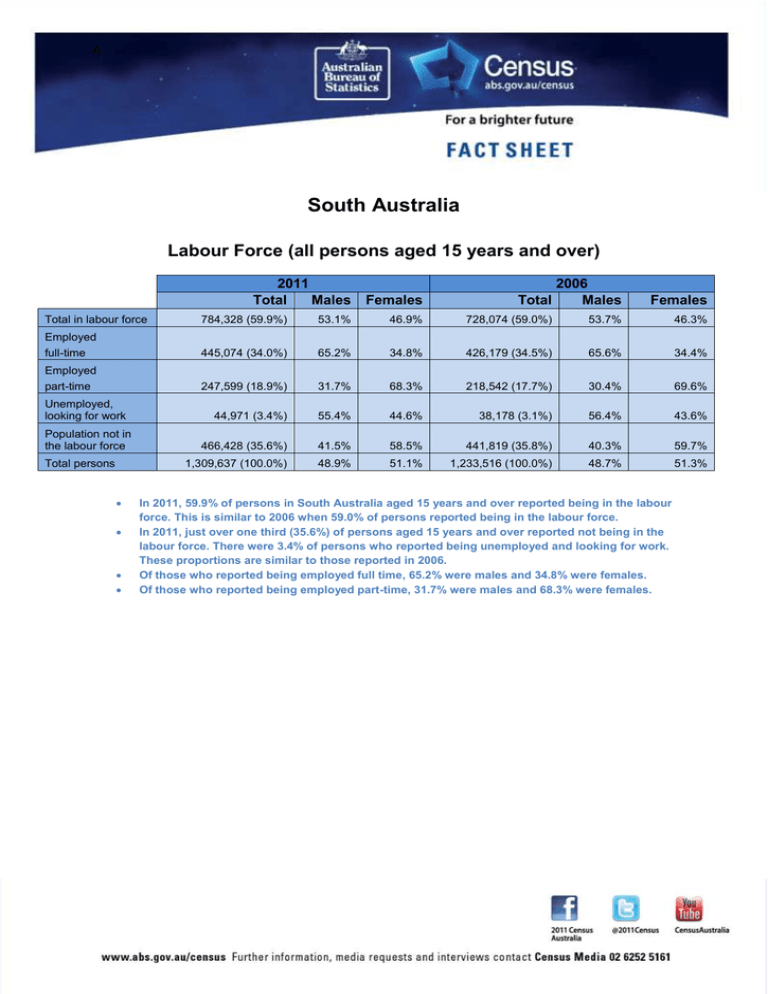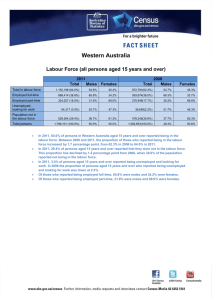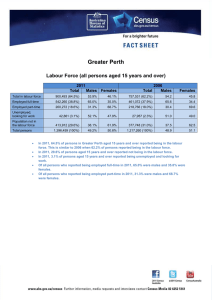South Australia Labour Force (all persons aged 15 years and over) A
advertisement

A South Australia Labour Force (all persons aged 15 years and over) 2011 Total Males Females 2006 Total Males Females Total in labour force 784,328 (59.9%) 53.1% 46.9% 728,074 (59.0%) 53.7% 46.3% Employed full-time 445,074 (34.0%) 65.2% 34.8% 426,179 (34.5%) 65.6% 34.4% Employed part-time 247,599 (18.9%) 31.7% 68.3% 218,542 (17.7%) 30.4% 69.6% 44,971 (3.4%) 55.4% 44.6% 38,178 (3.1%) 56.4% 43.6% 466,428 (35.6%) 41.5% 58.5% 441,819 (35.8%) 40.3% 59.7% 1,309,637 (100.0%) 48.9% 51.1% 1,233,516 (100.0%) 48.7% 51.3% Unemployed, looking for work Population not in the labour force Total persons In 2011, 59.9% of persons in South Australia aged 15 years and over reported being in the labour force. This is similar to 2006 when 59.0% of persons reported being in the labour force. In 2011, just over one third (35.6%) of persons aged 15 years and over reported not being in the labour force. There were 3.4% of persons who reported being unemployed and looking for work. These proportions are similar to those reported in 2006. Of those who reported being employed full time, 65.2% were males and 34.8% were females. Of those who reported being employed part-time, 31.7% were males and 68.3% were females. A South Australia Weekly Hours Worked (employed persons aged 15 years and over) 2011 2006 Total Males Females Total Males Females 40 hours and above 298,785 (40.4%) 70.8% 29.2% 295,530 (42.8%) 70.9% 29.1% 35-39 hours 146,288 (19.8%) 53.6% 46.4% 130,645 (18.9%) 53.6% 46.4% 25-34 hours 86,702 (11.7%) 32.4% 67.6% 75,963 (11.0%) 31.5% 68.5% 16-24 hours 72,517 (9.8%) 28.8% 71.2% 62,976 (9.1%) 27.2% 72.8% 121,002 (16.4%) 36.4% 63.6% 107,239 (15.5%) 36.0% 64.0% 739,359 (100.0%) 52.9% 47.1% 689,897 (100.0%) 53.6% 46.4% 0-15 hours Total persons In 2011, 40.4% of those who were employed and aged 15 years and over reported working 40 hours or more in the week prior to the Census. A higher proportion of these were males (70.8%). Between the 2006 and 2011 Census there was a 2.4 percentage point decline in the proportion of persons who reported working 40 hours or more (42.8% in 2006 compared to 40.4% in 2011). There were 16.4% of employed persons aged 15 years and over, who reported working 0 to 15 hours in the week prior to the Census. A higher proportion of these were females (63.6%). A South Australia Top five Industries in 2011 (employed persons aged 15 years and over) 2011 Total Males Health Care and Social Assistance Retail Trade Manufacturing Education and Training Construction Total persons 100,601 (13.6%) 83,070 (11.2%) 77,891 (10.5%) 58,639 (7.9%) 55,599 (7.5%) 739,359 (100.0%) 20.7% 43.2% 75.8% 30.9% 87.3% 52.9% Females 79.3% 56.8% 24.2% 69.1% 12.7% 47.1% 2006 Total Males 86,218 (12.5%) 81,399 (11.8%) 88,489 (12.8%) 52,376 (7.6%) 46,084 (6.7%) 689,897 (100.0%) Females 20.9% 43.5% 75.5% 31.6% 86.6% 53.6% In 2011, the largest proportion of employed persons, aged 15 years and over, reported working in the Health Care and Social Assistance industry (13.6%). This industry was also the most reported response in 2006 when 12.5% of persons reported working in it. In 2006, the proportion of people who reported working in Retail Trade industry was 11.8% which has declined to 11.2% in 2011; however there has been an increase in the number of persons employed in this industry (1,671 persons). The proportion of employed persons aged over 15 who reported Manufacturing as their industry of employment has declined to 10.5% in 2011 compared to 12.8% in 2006. There has been a decline in the number of persons who reported being employed in this industry (10,598 persons). In 2011, of those who reported working in the Manufacturing industry, 75.8% were males. In 2011 of those reported working in the industries of Health Care and Social Assistance, Education and Training, and Retail Trade, a higher proportion were females (79.3%, 69.1% and 56.8% respectively). 79.1% 56.5% 24.5% 68.4% 13.4% 46.4% A South Australia Top five Occupations in 2011 (employed persons aged 15 years and over) 2011 Total Males Professionals Clerical and Administrative Workers Technicians and Trades Workers Managers Labourers Total persons Females Total 2006 Males Females 145,126 (19.6%) 44.5% 55.5% 127,148 (18.4%) 45.7% 54.3% 106,216 (14.4%) 23.1% 76.9% 100,240 (14.5%) 23.4% 76.6% 104,589 (14.1%) 93,296 (12.6%) 82,325 (11.1%) 739,359 (100.0%) 84.3% 66.0% 63.8% 52.9% 15.7% 34.0% 36.2% 47.1% 97,745 (14.2%) 92,582 (13.4%) 85,886 (12.4%) 689,897 (100.0%) 84.2% 66.4% 62.4% 53.6% 15.8% 33.6% 37.6% 46.4% In 2011, 19.6% of employed persons in South Australia aged 15 years and over reported working as Professionals. Of those who reported working as Professionals, 55.5% were females. The proportion of those who reported working as Professionals has increased by 1.2 percentage points from 18.4% in 2006 to 19.6% in 2011. The proportion of those who reported working as Labourers declined (by 1.3 percentage points to 11.1% in 2011 from 12.4% in 2006). There was also decline in number of persons who reported working as Labourers. Of those who reported working as Technicians and Trades Workers (14.1%), a higher proportion were males (84.3%). This compared to 14.4% of persons reporting as Clerical and Administrative Workers of which 76.9% were females. A South Australia Highest Level of Education (all persons aged 15 years and over) 2011 Total Males Postgraduate Degree Graduate Diploma and Graduate Certificate Females Total 2006 Males 22,896 (1.9%) 58.1% 41.9% 36,000 (2.7%) 54.2% 45.8% Females 20,273 (1.5%) 36.2% 63.8% 16,099 (1.3%) 37.5% 62.5% 152,187 (11.6%) 43.1% 56.9% 120,978 (9.8%) 44.1% 55.9% 95,692 (7.3%) 43.3% 56.7% 79,698 (6.5%) 44.2% 55.8% Certificate III/IV 205,850 (15.7%) 69.4% 30.6% 176,067 (14.3%) 73.0% 27.0% Year 12 214,069 (16.3%) 45.9% 54.1% 195,335 (15.8%) 45.3% 54.7% 435,091 (33.2%) 44.5% 55.5% 458,605 (37.2%) 43.6% 56.4% 1,309,637 (100.0%) 48.9% 51.1% 1,233,516 (100.0%) 48.7% 51.3% Bachelor Degree Advanced Diploma and Diploma Year 11 or below (includes Certificate I/II/nfd) Total persons nfd: not further defined In 2011, there was a significant increase in number of persons who reported completing a Postgraduate Degree. This increased from 22,896 in 2006 to 36,000 in 2011 (a 57.2% increase). There has also been significant increase in numbers of those who reported completing a Graduate Diploma or Graduate Certificate as their highest level of education. This increased from 16,099 in 2006 to 20,273 in 2011 (an increase of 25.9%). There was a significant increase (25.8%) in the number of persons who reported completing a Bachelor Degree as their highest level of education, from 120,978 in 2006 to 152,187 in 2011. There has been a decline in number of persons who reported Year 11 and below (including Certificate level I/II), as their highest level of education, from 458,605 in 2006 to 435,091 in 2011. A higher proportion of females than males reported their highest level of education as Graduate Diploma or Graduate Certificate, Bachelor Degree, and Advanced Diploma or Diploma (63.8%, 56.9% and 56.7% respectively). Of those who reported completing Certificate III/IV as their highest level of education a higher proportion were males (69.4%). A South Australia Top five Fields of Study in 2011 (all persons aged 15 years and over who stated a completed qualification) Engineering and Related Technologies Management and Commerce Society and Culture Health Education Total persons Total 2011 Males Females Total 2006 Males Females 114,301 (16.8%) 94.0% 6.0% 106,747 (17.9%) 94.1% 5.9% 110,386 (16.2%) 74,783 (11.0%) 73,303 (10.8%) 49,825 (7.3%) 680,210 (100.0%) 41.6% 32.2% 21.7% 27.6% 52.1% 58.4% 67.8% 78.3% 72.4% 47.9% 85,445 (14.4%) 55,356 (9.3%) 59,927 (10.1%) 44,578 (7.5%) 595,382 (100.0%) 42.3% 34.1% 20.9% 28.1% 53.3% 57.7% 65.9% 79.1% 71.9% 46.7% In 2011, Engineering and Related Technologies (16.8%) and Management and Commerce (16.2%) were the two most common fields of study completed that were reported by persons aged 15 years and over. These fields were also reported as the most common fields of study in the 2006 Census. Between the 2011 and 2006 Census there has been a decline in the proportion of those who reported Engineering and Related Technologies (1.1 percentage points) but a proportionate increase in those who reported Management and Commerce (1.8 percentage points). The number of those reporting these fields of study completed has increased between 2006 and 2011. Of those who reported Management and Commerce, and Society and Culture as their field of study, a higher proportion were females (58.4% and 67.8% respectively). Of those who reported Engineering and Related Technologies as their field of study, the proportion of males was significantly higher (94.0%). Almost three quarters of those who reported Health, and Education as fields of study were females (78.3% and 72.4% respectively). A South Australia Top five Methods of Travel to Work in 2011 (employed persons aged 15 years and over) Car, as driver Car, as passenger Bus Walked only Bicycle Total persons 2011 2006 471,362 (63.8%) 39,168 (5.3%) 30,215 (4.1%) 23,621 (3.2%) 7,503 (1.0%) 739,359 (100.0%) 429,822 (62.3%) 38,719 (5.6%) 27,955 (4.1%) 24,865 (3.6%) 7,937 (1.2%) 689,897 (100.0%) Transport by car continues to be the most commonly reported method of travel to work. Just over two third (69.1%) of employed persons reported that they travelled to work by car (either as driver or a passenger) on 9 August 2011. The number of persons who walked to work has declined slightly from 24,865 (3.6%) in 2006 to 23,621 (3.2%) in 2011. There was also a minor decline in number of people who cycled to work from 7,937 (1.2%) in 2006 to 7,503 (1.0%) in 2011. A South Australia Place of Usual Residence one year ago (all persons who moved, excluding persons aged under one year) 2011 2006 174,940 (81.4%) 171,566 (81.4%) Interstate 20,112 (9.4%) 18,901 (9.0%) Overseas 17,543 (8.2%) 18,154 (8.6%) 215,031 (100.0%) 210,720 (100.0%) Within State Total persons Of the South Australian residents who moved in the year prior to the 2011 Census, most moved within the State (81.4%). There were 17,543 (8.2%) of persons who had moved to South Australia from overseas in the year prior to the 2011 Census. Place of Usual Residence five years ago (all persons who moved, excluding persons aged under five years) 2011 2006 409,363 (75.7%) 413,563 (80.1%) Interstate 50,178 (9.3%) 51,530 (10.0%) Overseas 74,495 (13.8%) 45,922 (8.9%) 540,598 (100.0%) 516,221 (100.0%) Within State Total persons More than three-fourth (75.7%) of the SA residents who moved five years prior to 2011 Census moved within the State. There were 74,495 (13.8%) of persons who had moved to SA from overseas five years prior to 2011 Census.








